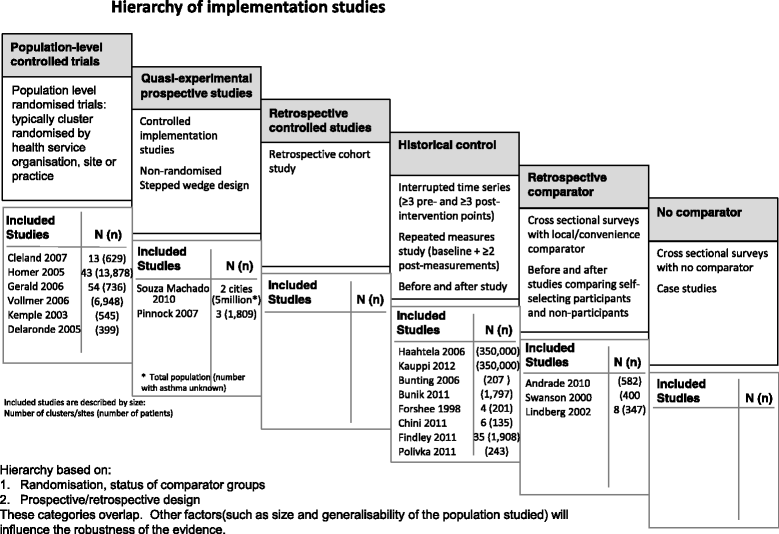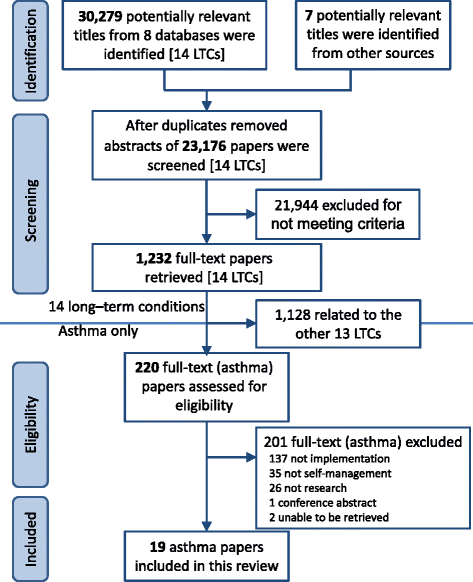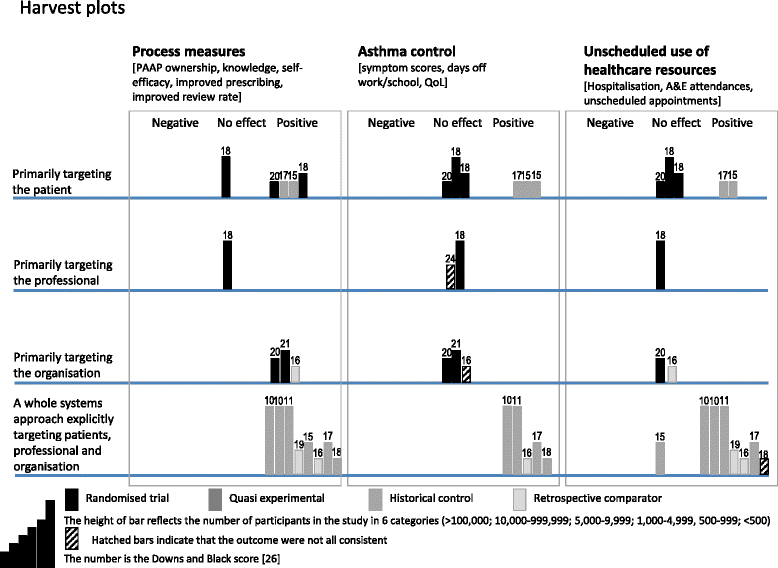Implementing supported self-management for asthma: a systematic review and suggested hierarchy of evidence of implementation studies
- PMID: 26032941
- PMCID: PMC4465463
- DOI: 10.1186/s12916-015-0361-0
Implementing supported self-management for asthma: a systematic review and suggested hierarchy of evidence of implementation studies
Abstract
Background: Asthma self-management remains poorly implemented in clinical practice despite overwhelming evidence of improved healthcare outcomes, reflected in guideline recommendations over three decades. To inform delivery in routine care, we synthesised evidence from implementation studies of self-management support interventions.
Methods: We systematically searched eight electronic databases (1980 to 2012) and research registers, and performed snowball and manual searches for studies evaluating implementation of asthma self-management in routine practice. We included, and adapted systematic review methodology to reflect, a broad range of implementation study designs. We extracted data on study characteristics, process measures (for example, action plan ownership), asthma control (for example, patient reported control questionnaires, days off school/work, symptom-free days) and use of health services (for example, admissions, emergency department attendances, unscheduled consultations). We assessed quality using the validated Downs and Black checklist, and conducted a narrative synthesis informed by Kennedy's whole systems theoretical approach (considering patient, practitioner and organisational components and the interaction between these).
Results: We included 18 studies (6 randomised trials, 2 quasi-experimental studies, 8 with historical controls and 3 with retrospective comparators) from primary, secondary, community and managed care settings serving a total estimated asthma population of 800,000 people in six countries. In these studies, targeting professionals (n = 2) improved process, but had no clinically significant effect on clinical outcomes. Targeting patients (n = 6) improved some process measures, but had an inconsistent impact on clinical outcomes. Targeting the organisation (n = 3) improved process measures, but had little/no effect on clinical outcomes. Interventions that explicitly addressed patient, professional and organisational factors (n = 7) showed the most consistent improvement in both process and clinical outcomes. Authors highlighted the importance of health system commitment, skills training for professionals, patient education programmes supported by regular reviews, and on-going evaluation of implementation effectiveness.
Conclusions: Our methodology offers an exemplar of reviews synthesising the heterogeneous implementation literature. Effective interventions combined active engagement of patients, with training and motivation of professionals embedded within an organisation in which self-management is valued. Healthcare managers should consider how they can promote a culture of actively supporting self-management as a normal, expected, monitored and remunerated aspect of the provision of care.
Systematic review registration: PROSPERO (registration number: CRD42012002898 ) Accessed 24 May 2015.
Figures



References
-
- Gibson PG, Powell H, Wilson A, Abramson MJ, Haywood P, Bauman A, et al. Self-management education and regular practitioner review for adults with asthma. Cochrane Database Syst Rev. 2002; Issue 3, Art No. CD001117. doi:10.1002/14651858.CD001117. - PubMed
-
- Bhogal SK, Zemek RL, Ducharme F. Written action plans for asthma in children. Cochrane Database Syst Rev. 2006; Issue 3, Art No. CD005306. doi:10.1002/14651858.CD005306.pub2. - PubMed
-
- Global Initiative for Asthma. Global Strategy for Asthma Management and Prevention 2014 update. http://www.ginasthma.org. Accessed 1 Oct 2014.
-
- British Thoracic Society/Scottish Intercollegiate Guideline Network. British Guideline on the Management of Asthma. 2014 update. http://sign.ac.uk/guidelines/fulltext/141/index.html. Accessed 24 May 2015.
Publication types
MeSH terms
Grants and funding
LinkOut - more resources
Full Text Sources
Other Literature Sources
Medical

